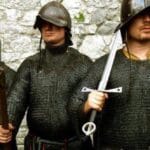Ah, the holidays! A time for cheer, goodwill, and… epic brawls? While Andy Williams croons about the “most wonderful time of the year,” reality can be a bit more, let’s say, spirited. The pressure cooker of family gatherings, rising costs, and endless expectations can sometimes make even the calmest soul crave a giant gulp of eggnog, potentially leading to some sparks flying. In fact, some say Christmas stress is a real factor in post-holiday blues and even relationship troubles.
But before you start dreading your own family’s quirky traditions or minor disagreements, let’s take a look at some truly monumental fights and battles that happened around the festive season. These 10 historical clashes might just put your own holiday squabbles into perspective!
10. Jack Johnson vs. Tommy Burns: A Boxing Day Showdown
On December 26, 1908, the day after Christmas, a historic boxing match took place in Australia. Tommy Burns had a strong record, defending his title 12 times. But Jack Johnson was determined. He didn’t just fight; he taunted Burns, even letting him land a few punches to show he wasn’t intimidated. Johnson’s confidence was sky-high.
The fight was intense, fueled by the racial tensions of the era. When Johnson decisively defeated Burns, the aftermath was so heated that police had to step in to stop the event. That day, Jack Johnson became the first Black world heavyweight champion. His victory sparked a series of racially motivated challenges, but Johnson continued to dominate. It’s a stark reminder that Boxing Day once lived up to its name in a very literal way.
9. Soviet Invasion of Afghanistan: A Christmas Eve Offensive
While Afghans, being predominantly Muslim, don’t celebrate Christmas, the Russians do. Imagine the surprise when, on Christmas Eve 1979, Soviet forces rolled into Afghanistan. Around 30,000 troops were deployed, overthrowing the existing government and installing a Soviet-backed leader, Babrak Karmal. This act plunged the nation into a devastating civil war that would claim an estimated one million civilian lives.
The Soviets found themselves in a grueling conflict against the U.S.-supported mujahideen. After nearly a decade of fighting, an agreement was reached involving Pakistan, the United States, and Afghanistan. Soviet troops completed their withdrawal on February 15, 1989, ironically impacting Valentine’s Day as well for those involved.
8. Sinking of the Belgian Ship Leopoldville: A Christmas Eve Tragedy
Originally a Belgian passenger steamship built in 1929, the Leopoldville was repurposed during World War II to transport troops. On Christmas Eve 1944, it was en route to Cherbourg, France, carrying U.S. soldiers to reinforce troops fighting in the Battle of the Bulge. Disaster struck when a German U-boat fired two torpedoes, hitting the Leopoldville.
The ship carried 2,235 American servicemen from the 66th Infantry Division and a crew of 139. The British destroyer HMS Brilliant rushed to rescue survivors, but rough seas hampered efforts. Tragically, 763 American soldiers, along with the ship’s master and 55 crew members, lost their lives in the icy waters just five miles from their destination.
7. The Battle of the Bulge: A Frigid Christmas Climax
Many dream of a picturesque white Christmas. However, the snow-covered Ardennes Forest in December 1944 was the scene of intense fighting. On December 16, Hitler launched his final major offensive of World War II, known as the Battle of the Bulge. Three German armies, with hundreds of thousands of soldiers, attacked along the front, aiming to capture Bastogne and reach Antwerp, Belgium.
This battle became one of the war’s bloodiest. The siege of Bastogne was a critical point, and on the day after Christmas, General George S. Patton Jr.’s Third Army famously broke through the German lines with his tank units, relieving the besieged American forces. The fighting, however, continued for weeks.
6. The Eggnog Riot of 1826: When Holiday Spirits Ran Too High
Sometimes, too much holiday spirit (of the alcoholic kind) can lead to trouble. This was precisely the case at the U.S. Military Academy at West Point in 1826. The academy’s 260 cadets, known for their fondness for drink, were displeased when authorities decided their traditional Christmas Eve eggnog would be alcohol-free. The cadets decided to take matters into their own hands, smuggling in whiskey to spike the nog.
What followed was a night of drunken revelry that escalated into a full-blown riot. Cadets vandalized property and even assaulted a superior officer. While up to 90 cadets could have faced charges, the academy, likely to avoid a major scandal, expelled 19 of the most aggressive participants. Interestingly, future Confederate President Jefferson Davis and General Robert E. Lee were cadets at the time and managed to avoid serious repercussions.
5. The Christmas Raid: A Confederate Strike on Union Supplies
During the American Civil War, disrupting enemy supply lines was a key tactic. Confederate General John Hunt Morgan was tasked with cutting Union Army supplies by targeting crucial railway points. In late December 1862, just after Christmas Day, Morgan led his cavalry on a daring raid into Kentucky. This operation became known as the Christmas Raid.
Morgan’s horsemen successfully attacked Union supply convoys carrying food and other essential materials from Louisville. They destroyed vital railway trestles and engaged in several skirmishes, inflicting significant losses on the Union. Having achieved his objectives, Morgan and his command returned to Tennessee a few days later.
4. Washington Crossing the Delaware: A Christmas Day Surprise
One of the most iconic moments of the American Revolution unfolded on Christmas Day, 1776. General George Washington’s Continental Army had suffered several setbacks, losing New York City and other key locations. Morale was low. Washington planned a bold move: a surprise attack on the Hessian forces garrisoned in Trenton, New Jersey, hoping to catch them off guard during their holiday celebrations.
Braving icy waters, Washington led about 2,400 of his men across the Delaware River. Many others, along with crucial artillery, couldn’t make the crossing in time due to the severe weather. On the morning of December 26, Washington’s troops surprised the Hessian defenders. Though the absence of the delayed artillery forced an eventual withdrawal, the victory at Trenton significantly boosted American spirits and became a turning point in the war.
3. Sinking of the Scharnhorst: A Boxing Day Naval Battle
The German battleship Scharnhorst was one of the Kriegsmarine’s most formidable warships, a constant threat in World War II. In December 1943, British intelligence learned that the Scharnhorst had sailed from its Norwegian base to attack an Allied convoy returning to Britain. The stage was set for a dramatic naval engagement on Boxing Day, known as the Battle of North Cape.
A British force, including cruisers like HMS Sheffield and HMS Norfolk, and the battleship HMS Duke of York, intercepted the Scharnhorst. In a fierce battle fought in harsh Arctic conditions, the German warship was outgunned and overwhelmed. After numerous hits from shells and torpedoes, the Scharnhorst sank. Of its crew of 1,968 men, only 36 survived the icy waters.
2. Italy’s Invasion of Ethiopia: A Christmas Counter-Offensive
Mussolini’s invasion of Ethiopia wasn’t going as smoothly as planned. On Christmas Day 1935, a 200,000-strong Ethiopian army launched a significant counter-offensive. This period became known as the “Black Period” for the Italian forces. In response to the setbacks and to bolster his fascist regime, Mussolini initiated the “Harvest of Gold” campaign back in Italy.
Italian citizens were urged to donate personal valuables, including wedding rings, to fund the war effort. In return for their gold, they received steel rings as a symbol of their commitment. Despite initial successes by the Ethiopian forces, Italy’s superior weaponry and illegal use of chemical warfare eventually crushed the resistance.
1. Takanakuy: Peru’s Christmas Day Fistfights
Perhaps the most unusual Christmas tradition involving fighting comes from the Chumbivilcas province of Peru. Takanakuy, which means “when the blood is boiling” or “to hit each other” in the local Quechua language, is an annual event held on Christmas Day. People of all ages and genders gather to settle grudges and disputes through public fistfights.
The goal of Takanakuy is to resolve conflicts and start the new year on a clean slate, particularly in communities with limited access to formal legal systems. Fights are typically one-on-one and are preceded and followed by hugs. This tradition, dating back to colonial times, is part of a larger festival involving dancing, drinking, and religious elements, making for a truly unique way to celebrate Christmas.
These stories show that the festive season hasn’t always been about peace and quiet. From major military campaigns to community brawls, history is filled with dramatic events that coincided with the holidays. It certainly makes you appreciate a calm Christmas dinner a little more!
What do you think of these festive fights? Do you know of any other historical holiday clashes? Leave your comment below!










